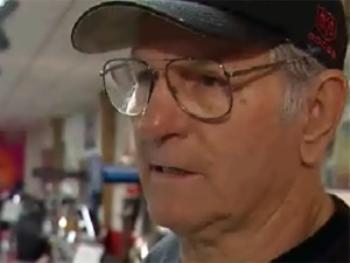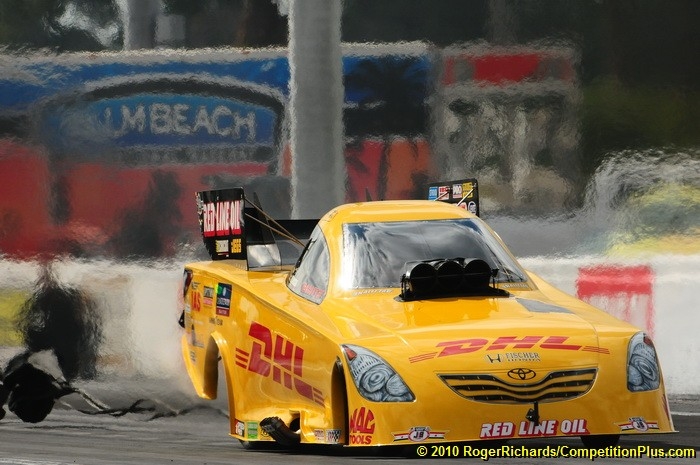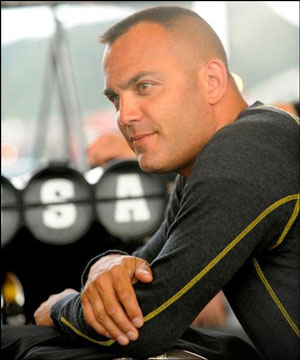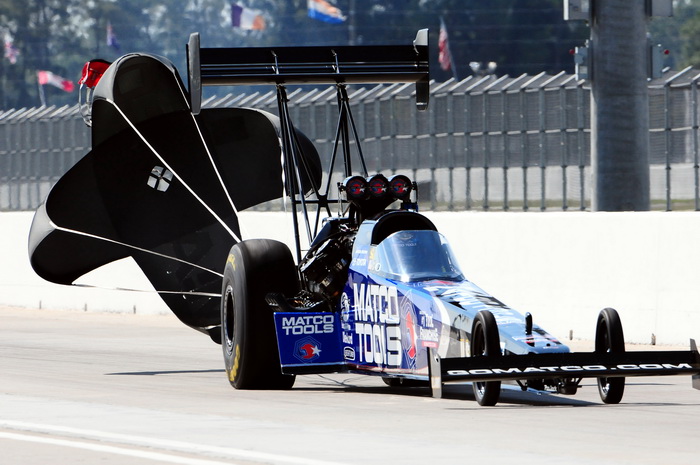1,000-FOOT DEBATE RAGES ON
Thu, 2011-02-17 14:00
Exactly 41 days before Scott Kalitta's fatal accident, drag-racing legend "Big Daddy" Don Garlits told 1320 TV in an interview from his Ocala, Fla., museum that if

Drag racing legend Don Garlits said in May of 2008, while nitro racing was still to 1320 feet, he'd love to see the NHRA cut the track to 1,000 feet and essentially run unlimited rules. [FirstCoaastNews.com Photo]
"I think I'd just shorten the distance," he said without hesitation May 11. 2008. "Instead of 1320 feet, I'd move 'em back to 1,000. And I'd take some of the restrictions off. I'd turn the guys loose, because they wouldn't have so far to race and every track would have 300 feet more shutoff. There's nobody down there at 1320 watching 'em, anyway. They're all back toward the start."
Well, crews chiefs today don't have carte blanche, but the NHRA did establish 1,000-foot racing after Kalitta's June 21, 2008, crash. And that's where the finish line remains today for nitromethane-fueled cars as the 2011 Full Throttle Drag Racing Series season begins with next weekend's Kragen O'Reilly Winternationals at Pomona, Calif.

Exactly 41 days before Scott Kalitta's fatal accident, drag-racing legend "Big Daddy" Don Garlits told 1320 TV in an interview from his Ocala, Fla., museum that if

Drag racing legend Don Garlits said in May of 2008, while nitro racing was still to 1320 feet, he'd love to see the NHRA cut the track to 1,000 feet and essentially run unlimited rules. [FirstCoaastNews.com Photo]
"I think I'd just shorten the distance," he said without hesitation May 11. 2008. "Instead of 1320 feet, I'd move 'em back to 1,000. And I'd take some of the restrictions off. I'd turn the guys loose, because they wouldn't have so far to race and every track would have 300 feet more shutoff. There's nobody down there at 1320 watching 'em, anyway. They're all back toward the start."
Well, crews chiefs today don't have carte blanche, but the NHRA did establish 1,000-foot racing after Kalitta's June 21, 2008, crash. And that's where the finish line remains today for nitromethane-fueled cars as the 2011 Full Throttle Drag Racing Series season begins with next weekend's Kragen O'Reilly Winternationals at Pomona, Calif.
The sport's purists have squawked. The NHRA has held its ground. And Top Fuel and Funny Car drivers have adjusted.
But people still ask the sports legends and leaders what they think. Do you like 1,000-foot racing? Should the NHRA extend the course to the quarter-mile? The debate surfaced again during Wednesday's NHRA media teleconference featuring Garlits, Don "The Snake" Prudhomme, Tony Schumacher, and Ron Capps.
Garlits said he reckoned that the 1,000-foot stripe is here to stay for the fuel cars.
"It probably is for lots of reasons," drag racing's renowned safety innovator said, tossing in his own reason that actually has nothing to do with the danger/protection yin and yang.
"I don't think it's a good idea to have two different distances at any racetrack. I sit in the stands and I watch it. You've got the scoreboards down there, and you watch all the cars go down. You get pretty much set in your mind where they're supposed to go, and that is the quarter-mile," Garlits said. "Then you see the fuelers and the funnies and it all looks like they shut off early, which, in fact, they do.
"I believe that NHRA will have to move the entire distance back to the 1,000 foot if that's what they want to run, because then all cars will go to the 1,000 foot and it will not appear to the fans who are paying the bills that the cars they came to see are shutting off early."
Prudhomme had a long answer and a short one.
His short one: "The 1,000 foot is fine, and I think they're [the cars are] going plenty fast enough."

Tony Schumacher doesn't mind running to 1,000 feet. In fact, he prefers it. [Sema.org photo]
His longer one: "They're going faster than ever, and we knew that was going to happen once they went to 1,000 foot -- that they were just going to turn the wick up, find more power, and run quicker to the 1,000-foot and they've achieved that. So to go to 1320 foot, put another 320 feet on the cars, there is a whole lot of damage between those two points on the racetrack, so I don't look to see it happen in the near future. I think the only way you can control a car is to probably [have] several things tossed around. But you'll have to have some electronics or something on it to signal when they have problems like engine damage and things like that."
Seven-time Top Fuel champion Tony Schumacher -- who said, 'I personally love 1,000 feet' -- knows the 1320 advocates still grumble about the shortened stripe. But he wraps the notions of safety, fan excitement, and business efficiency all into his bundle of opinion.
"I know there are some fans out there that want it back to a quarter mile. Yes, drag racing started out as a quarter mile, but it's 1,000 foot now. We have to enjoy it," he said.
"But here's the way I've always said it. . . . When the cars started and we ran 337 in Brainerd [Minn.] a few years back, they put these rev limiters on them. Well, everybody's not going to hit the rev limiters -- the cars that aren't going that fast [won't]. So what I always felt was we were penalizing the fastest cars," Schumacher said. "They weren't really seeing the best race, because you're seeing a car that goes real fast, get to 1,000 foot and drop three cylinders, which is total destruction.
"So when they went to 1,000 foot, I believe, I've seen the best racing ever," he said. "Races decided by inches time and time again, even some of the less-budgeted cars going out and running extremely well and making great racing. So I don't see the issue and the problems."
Schumacher has ridden out two nasty crashes at Memphis and has seen his U.S. Army Dragster buckle and break in two at Seattle. So he understands the value of security. That's one of the reasons he appreciates the 1,000-foot distance.
"It's been a lot safer," he said of making passes since the new rule. "I don't feel the fear that I used to feel going to 1320. I just lost a lot of the fear.
"I do understand part of racing is that fear, but we can't lose the drivers. We just can't do it," Schumacher said. "I lost some good friends, not like Snake and Big did. It was a different world back then. But we've all been part of it. We've all seen good people go for silly reasons and things that shouldn't happen.
"So I think what NHRA has done is what they had to do," he said. "I'm sure their insurance agents really appreciate it, because we just don't need that."
He, too, thought of the spectators, saying, "The fans don't want to come and see someone get hurt. They want to see a drag race. You can look back 10 years before we went to the 1,000 foot, and the racing wasn't as good. I mean, right now, it's hard to win these races. Everybody out there can get to 1,000 feet and get there quick. It makes the drivers sit up in the seat. We have to do our jobs on the start line and be a machine. I tell you, I really enjoy it right now."
Ron Capps, driver of the NAPA Dodge Charger Funny Car for Don Schumacher Racing, took in all the arguments and said, "Everybody makes a great point. But I think the biggest point is being missed, and that is the shutdown area is probably the biggest reason we're going to 1,000 feet. Because like Garlits and Prudhomme said, these crew chiefs will find a way to shorten up the fuse. When we raced the quarter-mile, the fuse was a little shorter than a quarter-mile most of the time. At 1,000 feet, sometimes the fuse is a little shorter than 1,000 feet now.

"But it's the shut down areas, the same tracks that have no area to build on the shut down area to slow us down. We don't mind running a quarter-mile," Capps said. "It's when you run 335 miles an hour and you've got to slow down on a track that was built for a car to go 250."
The Auto Club Raceway, home of the upcoming Winternationals, Capps said, "is a great example. It's one of the most historic racetracks we have, and there is a golf course at the end, and that's not going to change. NASA wouldn't send the space shuttle up into space if there was no way to land it or risky to land it."
Garlits agreed that "the shutoff is the key."
Said Garlits, "Every track now has 320 feet additional shutoff. That is a whole football field. A fuel dragster or Funny Car in trouble, a football field is everything," Garlits said. "I mean, that's so much distance that you get. It just gives the drivers so much more confidence to be able to have that distance and know it's down there if there is a problem. When you're dealing with an 8,000 horsepower engine, there is going to be a problem occasionally.
"I kind of think the 1,000 foot is here to stay," he said. "They could change it, change the cars and the way they're tuned and put together. They could get them where they'd only run, say, 300 in the quarter mile, but it would take drastic changes, and I don't see that happening and for what reason. It's all working just fine. Only thing I see is you've got two different racetracks and they shouldn't have that."
Capps advocated slowing down the cars, although he didn't sound terribly convinced that such a notion is possible.
"I think it's the smartest thing safety-wise to slow us down. The sport is built on a quarter-mile. It's what everybody talks about.," he said. "I think we're going to evolve and people are going to slowly just adapt. Tony said it best. A thousand foot is the closest race that we've had. But you've got to look at the history. We're going faster and faster and there's no way to slow us down."
{source}
<div style="float:left; padding:5px;"><script type="text/javascript">
google_ad_client = "pub-8044869477733334";
/* 300x250, created 4/3/09 */
google_ad_slot = "2028912167";
google_ad_width = 300;
google_ad_height = 250;
</script>
<script src="http://pagead2.googlesyndication.com/pagead/show_ads.js" type="text/javascript"></script>
</div><div style="padding:5px;">
<script type="text/javascript">
 sr_adspace_id = 2000000613807;
sr_adspace_id = 2000000613807; sr_adspace_width = 300;
sr_adspace_width = 300; sr_adspace_height = 250;
sr_adspace_height = 250; sr_ad_new_window = true;
sr_ad_new_window = true; sr_adspace_type = "graphic";
sr_adspace_type = "graphic";</script>
<script type="text/javascript" src="http://ad.afy11.net/srad.js?azId=2000000613807">
</script></div>
{/source}

Categories:




































